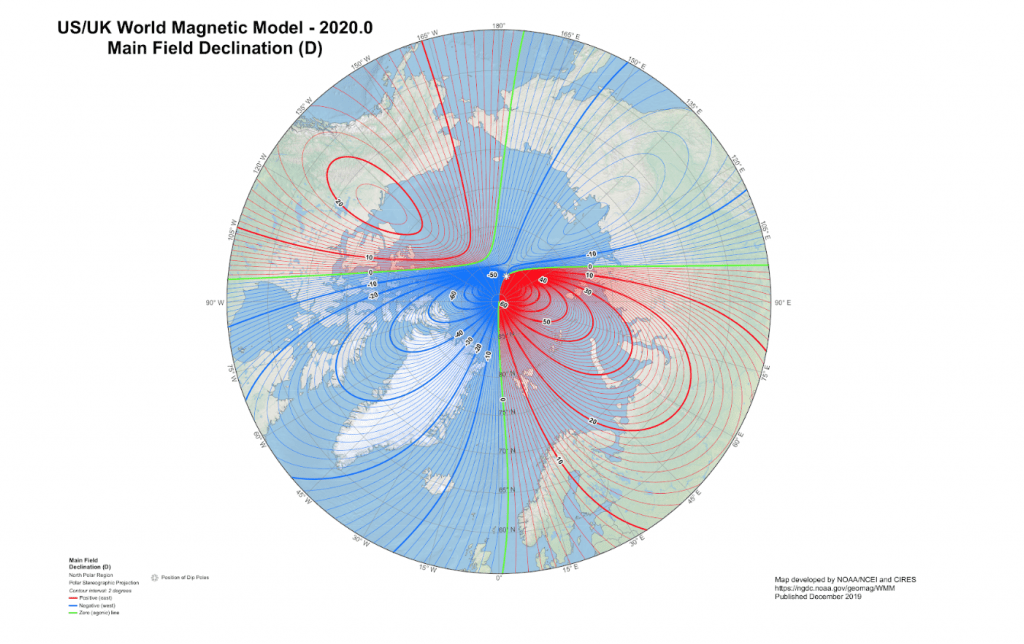Earth’s magnetic north pole, which has been wandering faster than expected in recent years, has now crossed the prime meridian.
The team of researchers that maintain the World Magnetic Model (WMM) has updated it and released it a year ahead of schedule due to the speed with which the pole is moving. The newly updated model shows the magnetic north pole moving away from Canada and toward Siberia.
The magnetic north pole is the point on the Earth that compasses designate as true north. It is the result of geological processes deep within the planet—molten iron flow creates a magnetic field with poles near the geographic North and South Poles. But unlike the geographic poles, the magnetic poles can move—and the magnetic north pole has been moving faster in recent years, which made necessary the early update of the WMM.
The WMM is a model maintained jointly by the U.S. National Oceanic and Atmospheric Administration and the British Geological Survey—its purpose is to show what Earth’s magnetic field looks like, most particularly, where the locations of the magnetic poles lie.
Data for the model comes from satellites and 160 land-based observatories. The model is normally updated every five years; thus, the next update is scheduled for 2025. THE WMM is important because of the critical role it plays in navigation—in addition to GPS, militaries around the world rely on it for a wide variety of navigational applications.

It is currently not known why the poles drift. Some have suggested it is due to an underground jet stream of sorts. Nor is the mechanism driving them understood. They were only discovered in 1831—since that time, both poles have been tracked, and the speed at which they move recorded. The north magnetic pole has traveled 1,400 miles since it was first discovered—and has changed speed, as well. As recently as 2000, the speed was clocked at 10 km/year. The latest readings show it moving at a brisk 50 km/year.
The increased speed of movement of the north magnetic pole is not expected to have much of an impact for most people—non-scientists may notice changes to GPS applications on smartphones and possibly re-designation of runway markers at airports.
Earth’s magnetic field is generated by the convection of molten iron in the planet’s core, around 1,800 miles beneath our feet. This superheated liquid generates electric currents that in turn produce electromagnetic fields. While the processes that drive pole reversal are comparatively less understood, computer simulations of planetary dynamics show that the reversals arise spontaneously. This is supported by observation of the Sun’s magnetic field, which reverses approximately every 11 years.
Our own magnetic field came into existence at least 4 billion years ago, and Earth’s magnetic poles have reversed many times since then. Over the last 2.6 million years alone, the magnetic field switched ten times — and, because the most recent occurred a whopping 780,000 years ago, some scientists believe we are overdue for another. But reversals are not predictable and are certainly not periodic.
READ MORE: Astronomers Discover a Free-Range Planet with Incredible Magnetism







Is the South pole moving also?
NOT AS MUCH AS THE NORTH POLE,WATCH MAVSTAR RELOADED ON YOUTUBE
magnetic pole movement is precursor to physical pole movement.
WATCH OUT WHEN THE MAGNETIC POLE REACHES 40 DEG LAT……………POLE WILL SWITCH
Why 40 degrees?
Përshëndetje! Fusha Magnetike e Tokës, nuk e ka burimin nga brënda. Polet magnetik nuk i kanë ndryshuar asnjëherë pozicionet e tyre dhe as do ti ndryshojnë. Fusha magnetike e Tokës vetëm po zvogëlohet, për të mos u ngritur më kurre vet. Por ajo mund të ngrihet pak sa, artificialisht.